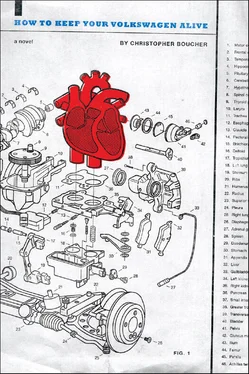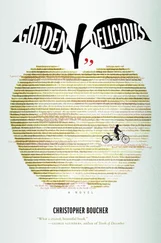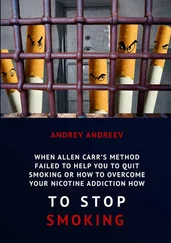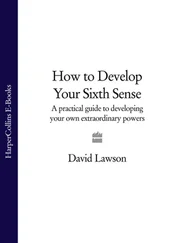Second, it’s possible that the scene clutch is failing to engage with one of the transmissions. To check the linkage, press your ear to the page and knock on it. Do you hear a hollow echo or the sound of metal against metal? If it’s the latter, the linkage — or the page — is probably twisted. You can either reshape the page by hand or get underneath the car, drop the transmissions, and use a pair of april-plyers to straighten out the twisted parts.
If both the linkage and the ignition appear to be OK, though, your next step should be to check the timing. The quickest way to do so is to open the engine compartment and take a look at the sun and moon(s). Watch them through at least one cycle (no matter how long it takes). Then decide: Are they timed correctly? Volkswagens have more problems with engine timing than any other car I know of — they constantly fall behind or speed forward, or slip from one version to another (both inside the engine compartment and on the road — in the story — itself!). My 1971 Beetle was notorious for this — I can’t tell you how many times we drifted unknowingly from one speed to the next. One minute the sun was hanging still in the sky, the next the moon was swimming laps around the earth. And I’ll never forget the time we found ourselves on a road on which the time wasn’t moving at all !
My advice is to try and avoid these situations if at all possible. There are ways to adjust the time if you find yourself lost in a shift, but most drivers in that situation simply keep their eyes on their surroundings — the traffic, the scenery, the road — and do their best to adjust.
FUEL EFFICIENCY
The most likely scenario is that there’s something wrong with your fuel system, though, so let’s review it.
First, check your stories. Are they burning quickly and completely? Sometimes, in order to render a story more likely to be burned, you need to strip an actual occurrence — a “true” story — down to its frame. Take “Rear Differential” for example, which I fed the VW out of desperation on one of our most trying trips, the wild chase west. That part was built from a change that actually did happen to me. I really did have a friend — not a bull but a barricade — who drove out to Hampshire College while we were both students in Boston, and he did have a jug of wine that he kept hoisting up and drinking out of as we drove. It was a cold night and I remember dropping him off at a lonely hut-like dorm at Hampshire, watching him knock on the front door, the potato on his face as he looked back at me, unsure if his friend was inside or not. Then the warm door opened and he slipped inside, and I drove off towards Smith, where my girlfriend at the time was waiting for me.
I saw this friend years later, in fact, his blond hair tamed and his face imprisoned by glass and metal. The Mechanical Bull was working in the city as a banker, his muscles pressed into a skintight grey suit.
My point is, the real story is soft and it licks your face but the one I fed the VW carries water and minerals — a bull, some hope, a home. But the vertebrae — the trip, the wine, the eyes, the campus — are in place, distilled and even truer than I remember them to be.
And why this particular story, this tune? I can’t say for sure why the VW chose it to burn, but I do know what drove me to tell it to him. There was real rubble to it; I was excited to be with this Bull, who I admired, and also frightened that his drinking might get us in trouble. The car felt smart and Hampshire felt like home, and it was one of those nights that I wished would pass but now would trade almost anything to return to.
None of these complicated procedures reach the surface, but they’re always happening nonetheless; words are burning, experiences changing, information is being transformed to actual motion. Even now, I still find that pretty amazing.
CONTROL UNIT
If the Volkswagen has fuel, its timing is set properly and each of the components of the fuel system — the minutepump, the sensors, the feeder and the morning cables leading to and from the compressorand expansion tank—seem to be working, you may have a problem with the control unit, which is to say that the VW might be stalling or not starting because he or she doesn’t want to move forward. They may be confused, mentally ill, overly cautious or simply upset about something.
I ran into this situation more than once with my car. In his third year, the 1971 VW grew tired of our routines — going to and from home, work and my parents’ house in Longmeadow. Then he heard Cooley-Dickinson’s song and he begged me to follow it. “How can you continue to spool around Northampton when the tune clearly goes west?” he said to me one evening as were driving to Hadley, where I was meeting a woman for dinner.
“Who says the farm went west?” I said. “You don’t know that for sure.”
“It’s what the hospital said,” the VW said. “It’s what we saw at the Castaway.”
“We’ve been over this,” I said. “I really don’t think that was the same farm.”
“It was the same farm,” said the Volkswagen. “I told you it was but you wouldn’t listen to me.”
I shrugged. “If it was then the Dogs will find him — they said they’d resume their search, didn’t they?”
“Still,” the VW said. “Why can’t we try too?”
“Because I said so,” I said.
“But why? ”
“Because we’d have to drive fast—”
“So?”
“—and the only way we could get west fast would be to take ninety-one north to two,” I said.
“Let’s do that, then!”
“I told you,” I said. “Ninety-one is off limits. There’s too much sound!”
“Too much sound? I can handle it,” he said.
“No you can’t,” I said.
“You never give me any credit,” the VW said.
“It’s not a matter of credit,” I said. “What if we broke down?”
“We won’t break down.”
“We always break down,” I said.
“We won’t this time.”
“You’re damn right we won’t, because we’re not going,” I said.
“How come I’m healthy enough to drive you places, but never to go anywhere I want to go?”
“Enough, OK? I said no.”
The VW mumbled something.
“What?” I said.
“Nothing,” he said.
“No, what?”
“Nothing,” he said again.
“It better have been nothing,” I said.
The VW was quiet for a minute, and so was I. I twisted the rearview mirror so that I could see my face. Then I said, “I feel nauseous — do I look pale?”
“Pale?”
“Am I underdressed?”
“You’re fine, jeez,” the VW said, and he took a right into the parking lot of the restaurant. This was Sienna — that fancy pasta cord a few miles from Amherst Center. The woman I was meeting — a Lady Made Entirely of Stained Glass (See “Valve Adjustment”) — was already there, waiting by her stained glass car.
I stepped out of the VW. “Hi,” she said.
“Hi,” I said, and I gave her a quick hug. She waved to the VW.
“Yo,” he said, his eyes oceaning.
Over the next few weeks, though, the VW became increasingly rambunctious, complaining of boredom and begging for trips. When I refused to give in he tried a new tactic: convincing me he was too sick to be my car. He’d complain of dizziness, halfburn or weak skin, fake an illness or a breakdown, pull over without warning, pretend to vomit or pass out from exhaustion. At first I was fooled — or fueled (hah!) — and I’d try to fix him: I’d get out of the car, grab my diagnostic tools and check his sensors, his morning cables, his oil. But soon I realized what he was up to and I stopped responding. When we broke down I’d simply wait for him to smarten up and get back on the road. Sometimes these charades went on for hours; once I even waited overnight. Sure enough, his engine turned over at around six the next morning and he drove us home without saying a word to me.
Читать дальше












